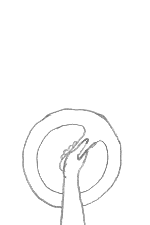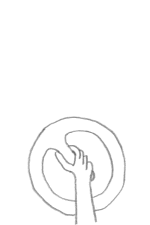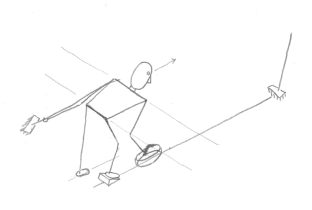Aim
- Before you begin your shot, take a moment to visualize the line between your foot and the broom.
- Before you begin your shot, check to see that your hips and shoulders are square and level.
- Before you begin your shot, check to see that rock is in fact on the line between your toe and the aim point. Many people place their rocks directly on the middle red line; this line goes between the two hacks, and thus lines up with neither of them.
- When you shoot, keep your hips and shoulders square and level.
- When you are ready to release the rock, don't undo everything you have accomplished by giving the rock an extra push with your arm.
- Release the rock cleanly, with a feather touch, don't flick it to either side.
Delivery
|
|
The delivery starts with the curler in the hack. The feet are a few inches apart, slider foot slightly forward, weight on the hack foot. The shoulders and hips are level and square to the broom. The rock lies on an imaginary line between the curler's hack foot and the broom. (Not the red center line painted on the ice) |
|
|
Next, pull the rock straight back to the toe of the hack foot, move the slider foot straight back, and transfer weight to the slider foot as the hips rise. |
|
|
To begin the kick-off, transfer weight back to the hack foot, and slide the slider foot onto the imaginary aiming line. |
 |
Push out from the hack, and slide on your slider foot. The hack foot should begin to trail behind you; the back knee should not touch the ground in theory, but worry about that later. The hips should now be low to the ground, and the back fairly straight up and down. The shoulders and hips should remain level throughout Lastly, release the rock without pushing it with the arm. |
Release
When a rock is thrown, it curls (hence the name curling). You can control in which direction the rock curls by placing spin on the rock as you release it. Your skip will indicate which direction the rock should turn by holding one arm up. As you begin your shot point the handle of the rock in the same direction as the skip's arm.
|
The OUT-TURN |
The IN-TURN |
 |
 |
 |
 |
|
Start at 2 o'clock, Release as rock passes through 12 |
Start at 10 o'clock, Release as rock passes through 12 |
The release is described as being similar to releasing someone's hand after a hand shake. The rock should slip lightly from the tips of your fingers. The spin is light and slow. You should not have to "force the rock" to spin.
Weight and Timing
Weight comes with practice. In time you will learn how hard to throw a given rock.There is often time before games to throw a few practice rocks, and doing so will make a world of difference.
An additional problem you must face, is that "draw weight" is not the same from day to day, sheet to sheet, or even from shot to shot. Thus, it impossible to find one weight that will consistently drop a rock on the button. This makes it hard to learn your weight and you should practice, practice, practice.
As a result curlers "time" the ice.
There are many system, and many variations. What is important is that a given ice time equals a certain stiffness of ice. In the most common system a rock is timed in seconds, from when it crosses the first hog line until it stops. If it stops on or near the tee line, that is the ice time. A low number is stiff ice, a high number is slick ice.
Here are some examples:
18: Frosty ice. Very stiff, becomes hard for some to get rocks to the house.
23: "Normal" ice. Often found at Leaside mid game.
25: Slick ice. Rock barely has to be thrown, sweeping can keep a rock going almost forever.
Learning your weight, is really learning where will a rock go with a given push, on a certain type of ice.
Example 1: Practice draws on 18 ice, if you remember it the next time you see 18 ice you will have an advantage, but shoot those draws on 23 ice, and the shots will bounce off the boards.
Example 2: Remember draw weight from a game where the ice was 23, you will do well on average Leaside ice, but try that same weight down the frosty edges, or after a fresh pebble, and you are guaranteed to hog.
Some curlers don't believe in timing, but even these curlers understand what kind of ice they are playing on. Most of them have simply curled so long that they can "feel" or judge the ice times based on how their rocks responded to their shots. Often they still talk about how the ice is running in terms of ice times, even if they never used a stopwatch.
The moral of this story: Don't try to just remember how hard you threw and also remember what kind of ice you were throwing on. Even if you don't time anything yourself, take a note of what others recorded for the ice you played on.




